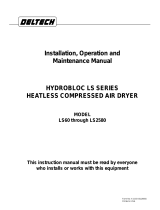Page is loading ...

Mounting instructions
EPS 50
Bubble Chamber
U.S. Version – 2" NPT for 3⁄8" O.D. - 1⁄8" I.D. tube
Maintenance
䡵Regularly check the bubble chamber – at least once a year – for debris and
correct alignment. Installation in locations with high sediment or vegetation
should be checked more frequently.
䡵To clean the chamber, remove the three Philips screws and the base plate of the
bubble chamber. The bubble chamber should be removed for cleaning. After
cleaning the bubble chamber alignment should be adjusted as described
above.
Note: the bubble in pressure must be built up again by purging the CBS for
~ 6 minutes. To do so, remove power from the CBS and reapply. This will initia-
te the commissioning purge cycle; refer to OTT CBS operating instructions for
more information!
Tee-fitting
2" metal pipe
Cap
EPS 50
2" metal pipe
Figure 4: Example of wall installation
(The figure shows a low water level.
The bubble chamber must be mounted
completely beneath the water surface.)
Base plate
NPT adapter
Philips
screws
Flange Bubble chamber
Figure 5: Cleaning the bubble chamber
If the bubble chamber is completely de-
tached from the bubble tube for cleaning,
trim the tube before connecting it again to
ensure it has a uniform surface.
Hach Environmental
5600 Lindbergh Drive
Loveland, CO 80538
1-800-949-3766
www.hachenvironmental.com
Document number
55.510.064.B.E 01-0708
Subject to technical changes!

Installation of the bubble chamber
The EPS 50 bubble chamber is designed for use with the OTT CBS bubble level
sensor. It reduces wave action near the measuring tube and minimizes influences
of waves.
The 2 inch male thread of the NPT adapter allows it to be connected to standard
plumbing materials configured to suit installation site conditions. It can be fixed to
natural and lined banks as well as vertical walls.
The bubble chamber must be installed in the direction of flow as shown in Figures
3 and 4.
䡵Install a conduit (metal or plastic) from the instrument (CBS) to the location
where the bubble chamber will be installed; see Figures 3 and 4. The conduit
should be fixed in place and terminate with a 2 inch NPT female threaded con-
nection at the bubble chamber location.
䡵Lead the bubble tube through the conduit.
䡵Cut the bubble tube at a 90° angle with a sharp blade (e.g., razor knife); see
Figure 1. Do not use scissors.
䡵Detach the NPT adapter from the bubble chamber by unscrewing the three
hexagonal screws of the bubble chamber’s flange.
䡵Install the NPT adapter on the end of the conduit.
䡵Insert the bubble tube as far as possible into the tube fitting. Rotate the nut until
finger-tight. While holding the bubble chamber steady, tighten the nut with a
wrench about one and one-quarter turns.
To disconnect the tube, untighten the nut and pull out the tube. Trim the tube
before connecting it again to ensure it has a uniform surface.
To reassemble, insert tubing with ferrules into the fitting until the front ferrule
seats. Rotate the nut with a wrench to the previously pulled-up position and
tighten slightly.
䡵Install the bubble chamber on the NPT adapter.
Note: For optimal measurement results the bubble chamber must be adjusted to
be horizontal and aligned in the direction of flow (max. tolerance ± 5°). The
EPS 50 has a ball-and-socket joint which allows for adjustment by 15° in any
direction. To install and adjust:
– Tighten the three hexagonal srews of the bubble chamber’s flange only slightly.
– Adjust the bubble chamber horizontally (both axes) and in the direction of
flow; see Figure 2.
– Tighten the screws using a wrench (size 10 mm).
Bubble chamber
Flange
Tube fitting
Nut
NPT adapter
Bubble tube
Figure 1: Connection of the bubble tube
Example of application: Installation in stream bed
Figure 3 shows a conduit fixed by driving a metal pipe with a 2 inch
tee-fitting into the stream bed.
Note that conduit and termination fitting such as tee-fittings and elbows are not
included with the EPS 50.
Example of application: Wall-mounting
Figure 4 shows two methods of mounting the bubble chamber on a wall. Note
that the bubble chamber must be secure enough such that it does not vibrate at
high velocities. For this purpose, as shown in the left drawing, the conduit can be
extended using a tee-fitting and anchored to the bed of the canal to increase sta-
bility. If this is not necessary, an elbow or capped tee-fitting can be used.
Figure 2: Adjusting the bubble chamber
max. tolerance of adjustment is ± 5°
Adjustment range: ±15°
Hexagonal screw
Figure 3: Example of stream bed installation
(The figure shows a low water level.
The bubble chamber must be mounted
completely beneath the water surface.)
EPS 50
Metal pipe
Tee-fitting
Plastic pipe (flexible)
/

